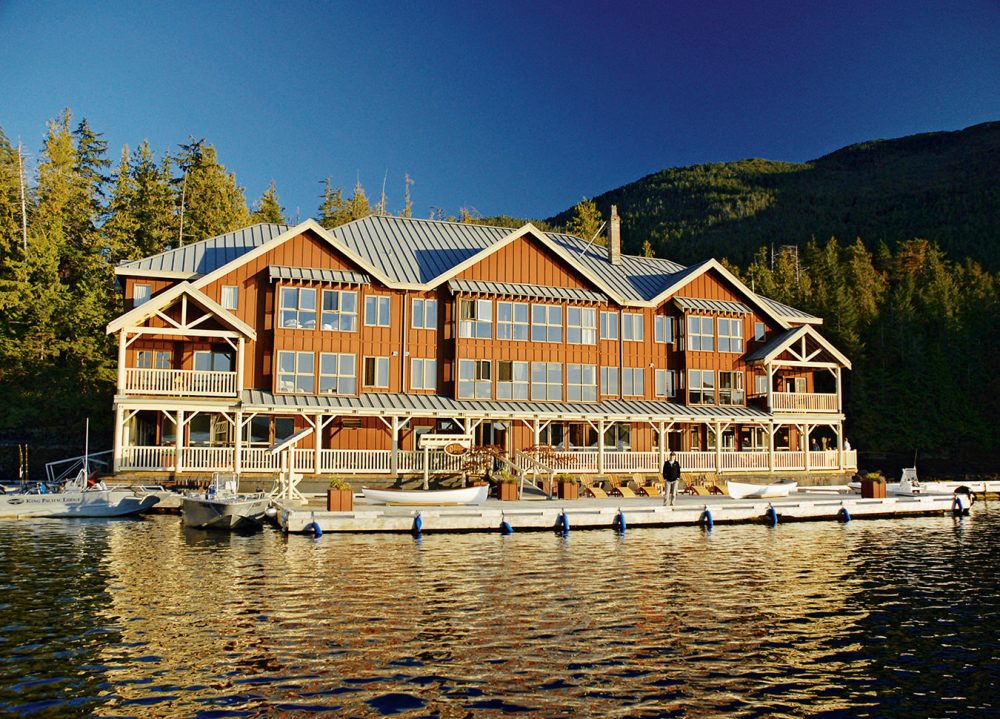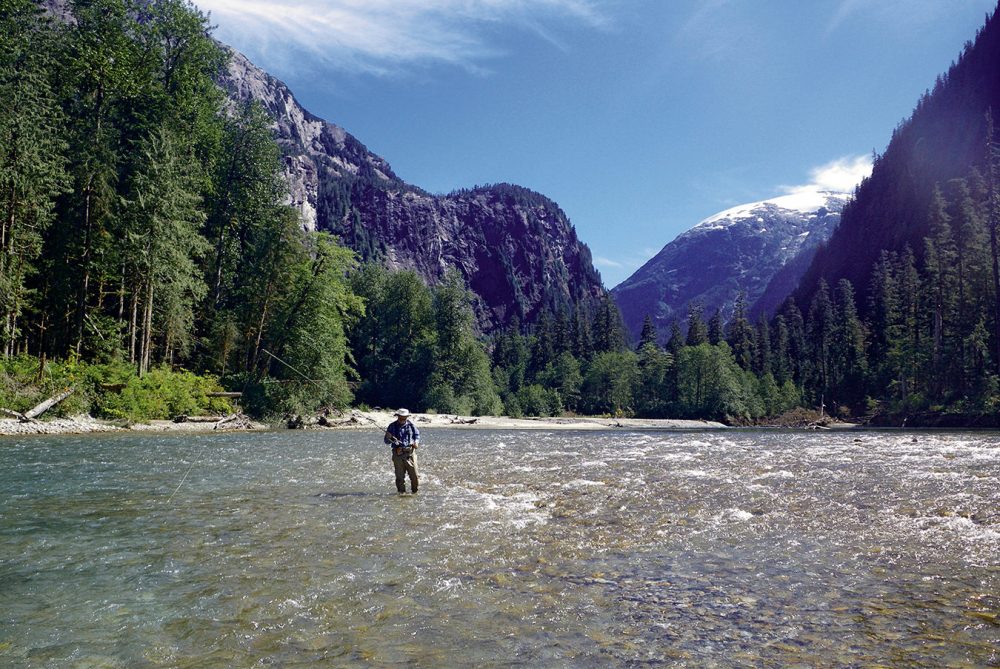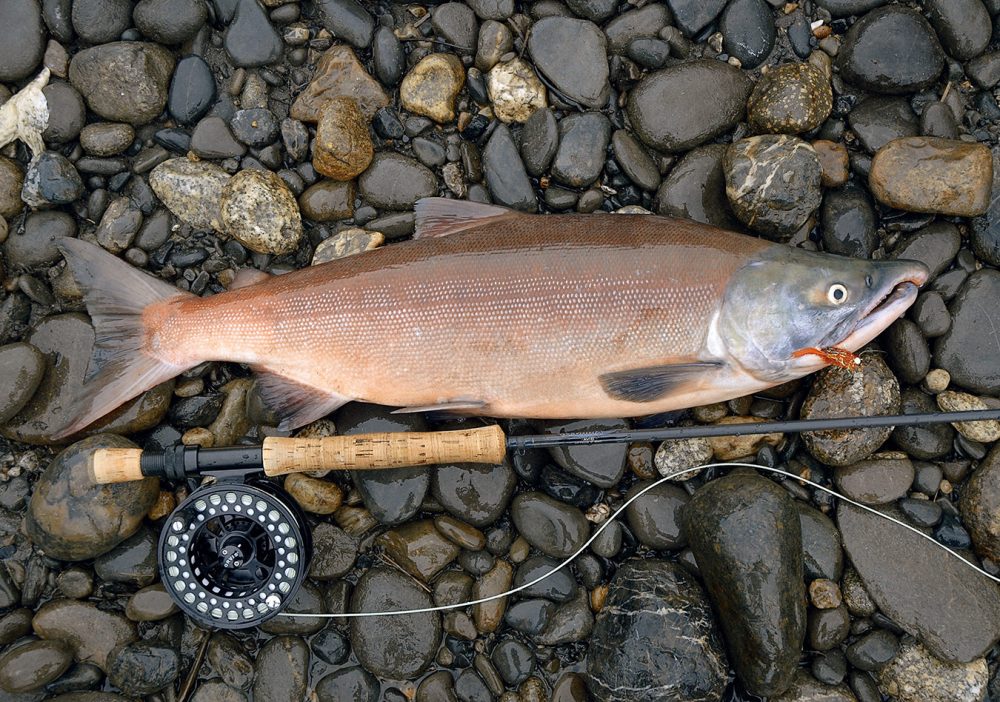From the northern end of Vancouver Island, across the Queen Charlotte Strait, and up to the Alaskan border, 21 million acres of pristine wilderness sweep across British Columbia’s coast. Here, western redcedar trees hundreds of years old continue to grow, undisturbed. Among other creatures, wolves, bears, moose, and deer roam. Today, nearly 60 per cent of the world’s coastal temperate rainforests have been logged or developed; the Great Bear Rainforest is one of the largest remaining on earth.
Nestled in the heart of this region is the King Pacific Lodge, a resort built from native pine, fir, cedar, and stone on a 37 by 18 metre long U.S. Army barge. Anchored to Princess Royal Island from May to September, the lodge is towed to Prince Rupert for the winter. The journey to the lodge via floatplane is breathtakingly beautiful and an integral part of experiencing the landscape in all its splendour. After a warm welcome accompanied by champagne and a quick briefing upon arrival, many set off immediately, eager to hook their first catch.
Ocean fishing, of course, is a huge draw at the lodge. Bottom feeders such as halibut, ling cod, red snapper, and sea bass are around all year but the best time to chase Chinook, the largest of the Pacific salmon species, is in June. They’re feisty and will put up a mighty fight, so it’s exhilarating to reel one in. While you’ll spot derby diehards hunting for that trophy fish, for many others fishing is just about being at sea with a cold beer in hand, good company, and yes, getting a few bites on the line. Out on the water, wildlife abound. You might glimpse gamboling Dall’s porpoises beside you. Sea lions bark and jostle for space on the rock, lolling around in the sun.
The lodge also offers helicopter-only access to isolated areas such as Gamble River and the Khutze River, where you can spend a day fly fishing for rainbow and cutthroat trout in connector streams between lakes, casting in utter solitude. Here, to protect the otherwise undisturbed ecosystem, it’s catch and release only. Salmon fly fishing is also an option for the angler looking for a heftier challenge.
But without the help of a whirlybird, there are still plenty of opportunities to explore other areas you won’t find labelled on Google Maps. Kayak to Cameron Cove at low tide and you’ll be agape at thousands of starfish beneath you. Or paddle to secluded Wolf Track Beach to enjoy an uninterrupted afternoon picnic. The fine sand is a dazzling white, marked only by animal tracks. It’s the kind of beach you would normally associate with the tropics; little do you know it’s here right in our backyard.
Embark on short hike, accompanied by ebullient interpretive guides who will lead you through the forest using trails maintained by wildlife to discover streams flowing from a nearby waterfall. Or take a full day and explore Campania Island; jump into Pender Lake for a dip and emerge refreshed. And at the end of a full and long adventure, return to the lodge for all the comforts of home.
Guests gather for supper every evening at 7:30 p.m. With lots to talk about (and the wine steadily flowing), your neighbours in the lodge quickly become family. It’s prime time to debrief, exchange tips, and inspire. Fresh sheets prepared by executive chef Jesse McCleery pay homage to the lodge owner’s Japanese heritage and involve local, fresh, and seasonal ingredients. The Pacific Northwest finds expression in dishes like the King Pacific Ramen, made with handmade alkaline noodles, barbeque pork, organic egg shiro miso, and kiel seaweed; or the crispy skin sablefish with braised daikon, beluga lentil, burnt kasu, and lardo. After dinner, sit out on the dock overlooking Barnard Harbour and watch the sun set. Stay even longer and watch the stars come out, brighter and in greater numbers than in the urban environment.
Salmon certainly lures the fisherman in every year but they’re even more important to a number of other species that depend, both directly and indirectly, on a healthy salmon run for survival. Resident orca can be spotted getting their fill in June and July, and while you’re out on the water fishing, you can be sure to spot a patient bald eagle doing the same.
Other marine creatures also find nourishment here. Each spring, after wintering in Hawaii, humpback whales migrate thousands of miles to Northern B.C., where the coast is rich with krill, herring, and pilchards. While you’re visiting these remote parts, it’s worth visiting full-time residents Janie Wray and Herman Meuter, on the southern end of Gil Island nearby. Dedicated to the conservation and study of whales, the pair approached the Gitga’at First Nation community in 2001 for permission to build a research station on their territory. Not only did the Gitga’at give their blessing, but they pointed Wray and Meuter to an auspicious place to set up shop—the confluence of three channels now known as Whale Point, where you might catch a humpback whale breeching, or a pod employing a cooperative hunting technique known as bubble net feeding.
In September, the elusive spirit bear ventures out for a spot of fishing. Found only in the central and north coast of B.C., the Kermode is a subspecies of the American black bear, their cream-coloured coat caused by a recessive allele. For centuries, the Tsimshian (which includes the Gitga’at) refused to hunt the bears, keeping them a secret from fur traders and ensuring their survival. The Kermode’s traditional habitat has shrunk significantly due to logging, and is still under threat today from topical encroaching developments.
Since 2007, the King Pacific Lodge has reduced their environmental footprint, offsetting emissions in all lodge operations as well as guest and employee air travel to create a carbon-neutral vacation. The lodge has played a pivotal role in the preservation of the Great Bear Rainforest, and continues to do so in partnership with the region’s original stewards, the Gitga’at community in Hartley Bay. Whether you’re visiting the lodge to fish, kayak, hike, or just to be in nature, it’s sure to be an experience that will make you appreciate the tremendous beauty that’s here in B.C. There is so much to see, but even more to protect.












